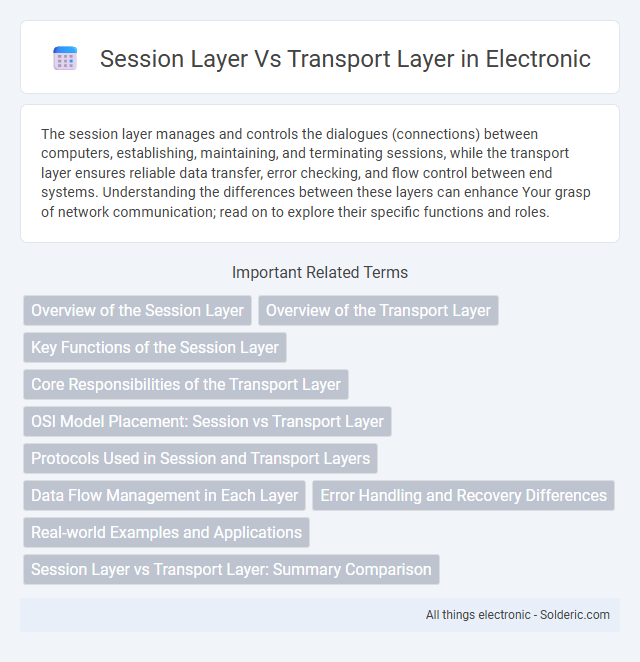The session layer manages and controls the dialogues (connections) between computers, establishing, maintaining, and terminating sessions, while the transport layer ensures reliable data transfer, error checking, and flow control between end systems. Understanding the differences between these layers can enhance Your grasp of network communication; read on to explore their specific functions and roles.
Comparison Table
| Feature | Session Layer (Layer 5) | Transport Layer (Layer 4) |
|---|---|---|
| Primary Function | Manages sessions and controls dialogs between computers | Provides end-to-end communication and reliable data transfer |
| OSI Model Layer | Layer 5 | Layer 4 |
| Key Protocols | RPC, NetBIOS, SAP | TCP, UDP |
| Connection Type | Manages session establishment, maintenance, and termination | Manages connection-oriented (TCP) and connectionless (UDP) transport |
| Data Flow Control | Controls dialog synchronization and checkpointing | Handles flow control, error correction, and segmentation |
| Error Handling | Supports recovery from session interruptions | Ensures data integrity through retransmission and error checking |
| Addressing | Session IDs to identify sessions | Port numbers to identify applications |
| Reliability | Provides session reliability | Provides reliable or unreliable transport based on protocol |
Overview of the Session Layer
The Session Layer, operating at Layer 5 of the OSI model, manages and controls the connections between computers, establishing, maintaining, and terminating communication sessions. It ensures synchronization and dialog control, enabling data exchange to resume seamlessly after interruptions. Your network applications rely on this layer to coordinate multiple data streams and provide organized communication for services such as remote procedure calls and session checkpoints.
Overview of the Transport Layer
The Transport Layer manages end-to-end communication, ensuring reliable data transfer between devices through error detection, flow control, and segmentation. Key protocols at this layer include TCP and UDP, which handle connection-oriented and connectionless transmissions respectively. Understanding the Transport Layer helps you optimize data delivery efficiency and maintain integrity in network communications.
Key Functions of the Session Layer
The Session layer manages and controls the dialog between two computers, establishing, maintaining, and terminating connections to ensure seamless communication. It handles session checkpoints and synchronization, which allows data recovery and efficient retransmission in case of interruptions. Your network benefits from these key functions by enabling organized and reliable data exchange during interactive communication sessions.
Core Responsibilities of the Transport Layer
The Transport layer is primarily responsible for ensuring reliable data transfer between devices, managing error detection and correction, flow control, and segmentation of data into smaller packets. It establishes end-to-end communication sessions and ensures complete data integrity, unlike the Session layer, which manages session establishment, maintenance, and termination. Your network's data reliability and error management heavily depend on the Transport layer's efficient handling of these core responsibilities.
OSI Model Placement: Session vs Transport Layer
The Session layer, positioned as Layer 5 in the OSI model, manages and controls the connections between computers, establishing, maintaining, and terminating sessions. The Transport layer, situated at Layer 4, ensures reliable data transfer through error correction and flow control, providing end-to-end communication. Understanding the OSI model placement helps you grasp how data travels through each layer, with the Session layer focusing on managing dialogues and the Transport layer ensuring data integrity and delivery.
Protocols Used in Session and Transport Layers
The Session layer employs protocols such as NetBIOS, SAP (Session Announcement Protocol), and PPTP (Point-to-Point Tunneling Protocol) to establish, manage, and terminate sessions between applications. In contrast, the Transport layer uses key protocols like TCP (Transmission Control Protocol) for reliable connection-oriented communication and UDP (User Datagram Protocol) for connectionless data transfer, ensuring end-to-end data delivery and flow control. These protocol distinctions highlight the Session layer's role in session management versus the Transport layer's responsibility for data transport and integrity.
Data Flow Management in Each Layer
The Session layer manages data flow by establishing, maintaining, and terminating communication sessions between applications, ensuring synchronization and dialog control. The Transport layer handles end-to-end data flow control through segmentation, acknowledgment, error detection, and retransmission to provide reliable or unreliable data transfer. Session layer focuses on dialogue control and connection establishment, while Transport layer ensures data integrity and proper sequencing across networked devices.
Error Handling and Recovery Differences
The Session layer primarily manages dialogue control and synchronization between communication sessions, handling error detection through checkpointing and recovery to resume data transfer from the last checkpoint. In contrast, the Transport layer is responsible for end-to-end error detection and correction using mechanisms like retransmission, flow control, and error recovery to ensure reliable data delivery. Your network's reliability depends on Transport layer protocols such as TCP for robust error handling, while the Session layer supports maintaining session continuity despite disruptions.
Real-world Examples and Applications
The Session layer manages connections in applications like video conferencing and online gaming by establishing, maintaining, and terminating communication sessions. The Transport layer, exemplified by TCP and UDP protocols, ensures reliable data transfer and error correction for applications such as web browsing, email, and file transfers. While the Session layer controls dialog synchronization, the Transport layer handles packet delivery and flow control essential for seamless network communication.
Session Layer vs Transport Layer: Summary Comparison
The Session layer manages and controls the connections or sessions between computers, providing synchronization, dialog control, and session recovery, while the Transport layer ensures reliable data transfer, error correction, and flow control between end systems. Key protocols at the Transport layer include TCP and UDP, emphasizing data segmentation and reassembly, whereas the Session layer handles initiating, maintaining, and terminating sessions. The Transport layer operates at a lower level focused on end-to-end communication, whereas the Session layer facilitates the organization and synchronization of communication sessions across networks.
Session layer vs Transport layer Infographic

 solderic.com
solderic.com